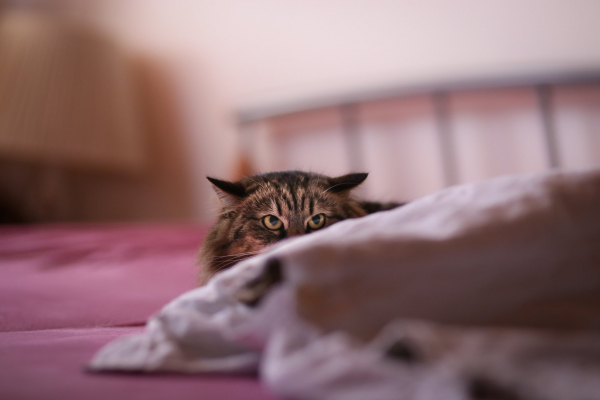Podzim láká k dogtrekkingu
Úporná vedra pominula a lesy hrají všemi barvami. To je ideální čas na dogtrekking. Udělejte něco pro svoje i pejskovo zdraví a vyrazte do přírody v zápřahu!
I have already written about dogs and how they (don’t) feel pain. So let’s look at cats. It is often not very simple to recognize. But the early recognition of the problem is important for their health and well-being.


I have already written about dogs and how they (don’t) feel pain. So let’s look at cats. It is often not very simple to recognize. But the early recognition of the problem is important for their health and well-being.
As I have already written in the article about how dogs feel pain, the animals were in the past considered to be some third-rate creatures controlled by their instincts and therefore their pain was not taken into account. René Descartes took the view that the animals have been created on Earth for the benefit of man. That they do not have a soul and the people are not guilty in terms of morals when they kill animals. This proposition also got into biology and the scientists used it to entitle themselves to treat animals unethically and cruelly.
But animals are not machines, their nerve system has developed the same way ours has and regarding the evolution, the ability to feel pain increases prospects for survival of the individual and it helps to avoid the sources of danger.
Of course, today we already know (at least the majority of us) that animals can feel pain as well as we do and we usually care about that. The problem may be to notice the pain of the animal.
Cats, just like dogs, hide their pain. And they are supposed to be even better at this. So it is up to us to observe the changes in their behaviour. Every cat is different and has its own specific habits and therefore we need to be attentive to any minor deviations from its normal behaviour.
Here is a list of certain situations that normally indicate that a cat feels pain and perhaps there could be something wrong with her:
If you have observed any of the things above and you worry, it is certainly good to visit a vet. Prevention and check-up is always a better choice than to ignore it and do not think it’s important. You can not only help your cat not to suffer from pain but you can also avoid its early death or consequences for life.


Úporná vedra pominula a lesy hrají všemi barvami. To je ideální čas na dogtrekking. Udělejte něco pro svoje i pejskovo zdraví a vyrazte do přírody v zápřahu!


Rozhodli jste se sobě anebo dětem pořídit mazlíka a volba padla na křečka? Tápete však jakého vybrat? Který druh je nejaktivnější, a který zase nejmazlivější? Pro koho se jaký vůbec hodí?


Chlorid sodný je velmi důležitou součástí psí stravy, stejně jako té naší. Udržuje v chodu několik důležitých procesů v těle. Nadbytek soli ale může mít na psa velmi negativní účinek hned v několika směrech.


American Curl má velmi nápadný zjev díky svým dozadu natočeným uším. Mimo Spojených států, kde toto plemeno vzniklo, je ještě celkem vzácností. Už i u nás ho ale najdete. Je to velmi společenská kočka, které doma nic neunikne.


V listopadu se koná překvapivě hodně akcí pro psy. Ať už jde o závody nebo výstavy. Zvláště v Praze je pak z čeho vybírat. Podívejte se, kam můžete se svým pejskem před zimou ještě vyrazit.


Ačkoli jde o malého psíka, teriéra v sobě prostě nezapře. Je to oddaný pes napumpovaný energií, který má v sobě stále pudy lovce krys.


Vědci došli k závěru, že majitelé koček jsou méně depresivní, úzkostní nebo uzavření. Vylučuje se to tedy s představou stereotypu “divných kočičích dam”, které si chlupaté parťáky pořizují kvůli osamělosti.


U psů začíná stáří mezi 5. a 8. rokem života. Vstupují tak do fáze, kdy se jejich potřeby mění, ať už jde o péči, pohyb nebo stravu. Aby si i nadále udrželi svou vitalitu a radost ze života, je potřeba to respektovat.


Jistě mi dáte za pravdu, že kočky se v pohádkách objevují docela často. Dnes se podíváme na českou klasiku. Pojďte si zavzpomínat a připomenout si dětství.


O nově vzniklém registru psích dárců krve už jsem psala. Pojďme se tedy podívat, jak samotné darování krve probíhá, kdo ho může podstoupit a proč je tak důležité. Třeba někoho z vás přesvědčím, aby se do registru se svým parťákem zapsal.


Je podzim a kočky se převlékají do svých zimních kabátů. My tuto skutečnost pociťujeme hlavně při uklízení domácnosti. Těch chomáčů chlupů je najednou víc, jsou větší a oblečení odchlupujeme dvakrát tak dlouho. Jak nad kočičími chlupy vyhrát nejen v...


Posvátná kočka z Barmy má nápadný exotický výraz. Asi o žádném jiném plemeni se nevede tolik hypotéz o původu, jako o těchto klidných a rozumných kočkách.